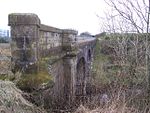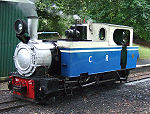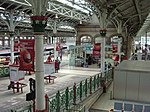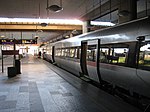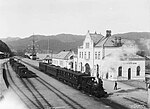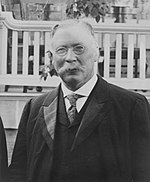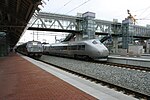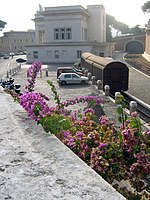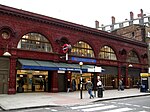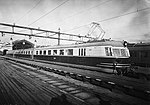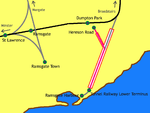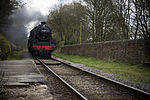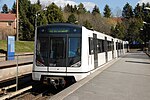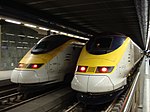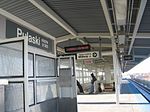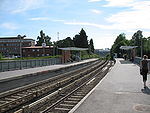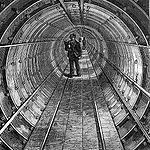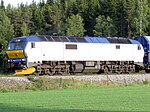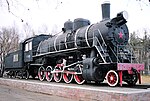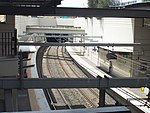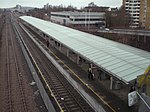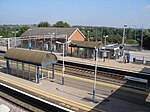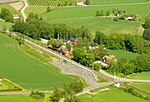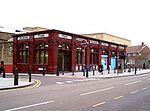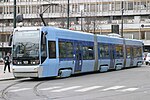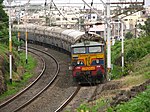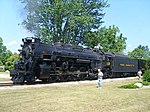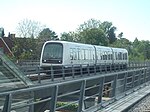Portal:Trains/Selected article/2009 archive
This is an archive of article summaries that have appeared in the Selected article section of Portal:Trains in 2009. For past archives, see the complete archive page.
- Week 1
- January 1–3
The Altoona and Beech Creek Railroad was a narrow gauge railroad in Blair and Cambria counties, Pennsylvania, which operated during the late 19th and early 20th century. It carried passenger traffic up from the vicinity of Altoona to Wopsononock and coal and timber down from Wopsononock and Dougherty to Altoona. Originally constructed to develop coal mines and resort traffic atop the Allegheny Plateau, it became involved in a complicated and ultimately unsuccessful scheme to break the Pennsylvania Railroad's control over the Clearfield Coalfield. Never very profitable, it went through several reorganizations, the last in 1913. Conversion to standard gauge in 1916 did not improve the situation, and the railroad was abandoned in 1921.
Recently selected: LSWR S15 class - Trondheim Central Station - Edgar Speyer
- Week 2
- January 4–10
The Glasgow, Paisley, Kilmarnock and Ayr Railway (GPK&AR) was a railway in Scotland that provided train services between Glasgow, Kilmarnock and Ayr. For a short period, it also provided West Coast services between Glasgow and London. Opened in stages between 1839 and 1848, the line ran from Paisley in the north to Cumnock and Ayr in the south. The section between Paisley and Glasgow was jointly owned by the Glasgow, Paisley and Greenock Railway. The GPK&AR merged with the Glasgow, Dumfries and Carlisle Railway to form the Glasgow and South Western Railway (G&SWR) in 1850, which was in turn incorporated into the London, Midland and Scottish Railway (LMS) in 1923, and later nationalised to become part of British Railways in 1948. Since nationalisation the line has suffered numerous cutbacks and closures, mostly due to the Beeching Axe. As a result over half of the stations on the line are now closed. Most of the line and remaining stations are still in use as part of the Ayrshire Coast Line and Glasgow South Western Line.
Recently selected: Altoona and Beech Creek Railroad - LSWR S15 class - Trondheim Central Station
- Week 3
- January 11–17
Everard Richard Calthrop (1857–1927) was a British railway engineer and inventor. Calthrop was a promoter and builder of narrow gauge railways, especially of 2 ft 6 in (762 mm) gauge, and was especially prominent in India. His most notable achievement was the Barsi Light Railway which opened in 1897; however he is best known in his home country for the Leek and Manifold Valley Light Railway in Staffordshire, which operated from 1904 to 1934. Later in life Calthorp took an interest in aviation, patenting some early designs for parachutes.
Recently selected: Glasgow, Paisley, Kilmarnock and Ayr Railway - Altoona and Beech Creek Railroad - LSWR S15 class
- Week 4
- January 18–24
Preston railway station serves the city of Preston in Lancashire, England, and is a major station on the West Coast Main Line. It is served by Northern Rail, Virgin Trains, and TransPennine Express services, plus First ScotRail overnight sleeper services between London and Scotland. When the station was first opened in 1838 by the North Union Railway, the line north of the station passed through a tunnel under the west end of Fishergate (then Preston’s major thoroughfare). It was on a slope so steep that sometimes station staff had to push trains out of the station. The station’s first expansion came in 1850 when the new East Lancashire line used new platforms staffed and managed by the East Lancashire Railway, with their own entrance and booking office in Butler Street. The condition of the station deteriorated to the extent that on 18 August 1866 part of the roof on the East Lancashire side collapsed injuring three people, one seriously. By then, 150 trains a day passed through the station. Eventually the station was rebuilt, at a cost of a quarter of a million pounds, reopening in July 1880.
Recently selected: Everard Calthrop - Glasgow, Paisley, Kilmarnock and Ayr Railway - Altoona and Beech Creek Railroad
- Week 5
- January 25–31
The Milwaukee Road, officially the Chicago, Milwaukee, St. Paul and Pacific Railroad (CMStP&P RR) (reporting mark MILW), was a Class I railroad that operated in the Midwest and Northwest of the United States from 1847 until its merger into the Soo Line Railroad on January 1, 1986. The company went through several official names and faced bankruptcy several times in that period. While the railroad does not exist as a separate entity anymore, it is still commemorated in buildings like the historic Milwaukee Road Depot in Minneapolis, Minnesota, and in railroad hardware still maintained by railfans, such as the Milwaukee Road 261 steam locomotive.
Recently selected: Preston railway station - Everard Calthrop - Glasgow, Paisley, Kilmarnock and Ayr Railway
- Week 6
- February 1–7
The Inverclyde Line is a railway line running from Scotland's Glasgow Central station through Paisley (Gilmour Street) and a series of stations to the south of the River Clyde and the Firth of Clyde, terminating at Gourock and Wemyss Bay, where it connects to Caledonian MacBrayne ferry services. The line was opened by the Glasgow, Paisley and Greenock Railway on March 31, 1841, between Glasgow and Greenock and was the first passenger service to follow the River Clyde to the coast. In the 1923 grouping, the line became part of the LMS. The line was electrified in 1967, and continues in operation today. In 2006, a proposed extension to Glasgow Airport was approved.
Recently selected: Milwaukee Road - Preston railway station - Everard Calthrop
- Week 7
- February 8–14
Oslo Airport Station (Norwegian: Oslo lufthavn stasjon), also known as Gardermoen Station, is a railway station located in the terminal building of Oslo Airport, Gardermoen, in Norway. Located on the Gardermoen Line, it is served by the Airport Express Train, express trains to Trondheim and Oslo, regional trains to Lillehammer and Skien (via Oslo) and commuter trains to Eidsvoll and Kongsberg (via Oslo). The station is located 48 kilometres (30 mi) from Oslo S. The station is manned, and there is a single bus route, and several coach services, to and from the airport. It opened in 1998, along with the new airport. During 2000–01, there were several derailments at the station. South of the station is a terminal for unloading trains carrying aviation fuel.
Recently selected: Inverclyde Line - Milwaukee Road - Preston railway station
- Week 8
- February 15–21
Flekkefjord Station (Norwegian: Flekkefjord stasjon) is a former railway station located in Flekkefjord, Norway. It served as the terminus of the 1,067 mm (3 ft 6 in) gauge Flekkefjord Line from 1904 to 1990. The station building was drawn by Paul Armin Due and was built in brick Art Nouveau. The station was important for transport along the coast until 1944, when the completion of the Sørland Line made Flekkefjord a branch station. At the same time, the line was converted to standard gauge, the number of station tracks was reduced, and the station received an overhaul. The station building was demolished in 1970, but the station was still served until the line closed in 1990. The tracks and depot buildings still exist as of 2009.
Recently selected: Oslo Airport Station - Inverclyde Line - Milwaukee Road
- Week 9
- February 22–28
The 2008 Chatsworth train collision occurred at 16:22 PDT (23:22 UTC) on Friday September 12, 2008, when a Union Pacific freight train and a Metrolink commuter train collided head-on in the Chatsworth district of Los Angeles, California, in the United States. The scene of the accident was a curved section of single track on the Metrolink Ventura County Line just east of Stoney Point. Before the collision, the Metrolink train may have run through a red signal before entering a section of single track where the opposing freight train had been given the right of way by the train dispatcher. The Metrolink train's engineer was near the end of a work week of long split shifts, making fatigue a subject of the investigation, along with distraction from text messages he was sending while on duty. The accident remains under investigation; meanwhile the basic circumstances have been released to the public, but the official report determining probable cause is expected to take up to a year to complete. This mass casualty event brought a massive emergency response by both the city and county of Los Angeles, but the nature and extent of physical trauma taxed the available resources. With 25 deaths, this became the deadliest accident in Metrolink's history. Many survivors remained hospitalized for an extended period. Lawyers quickly began filing claims against Metrolink, and in total, they are expected to exceed a US$200 million liability limit set in 1997, portending the first legal challenges to that law. Issues surrounding this accident have also initiated and reinvigorated public debate on a range of topics including public relations, safety and emergency management, which has also resulted in regulatory and legislative actions.
Recently selected: Flekkefjord Station - Oslo Airport Station - Inverclyde Line
- Week 10
- March 1–7
NSB Gjøvikbanen AS is a Norwegian railway company that operates the passenger train service on the Gjøvik Line. A subsidiary of the state-owned Norges Statsbaner (NSB), it operates a fleet of nine Class 69g three-car electric multiple units. NSB Gjøvikbanen provides two different services: the Skøyen – Oslo S – Jaren service is part of the Oslo Commuter Rail; while Oslo S – Gjøvik is a regional service, with only limited stops on the route until Grua. Departures are each 40 minutes, with every third train running to Gjøvik. The company was created in 2004 as NSB Anbud AS to compete for the tender bid for a ten-year public service obligation (PSO) contract with the Norwegian Ministry of Transport and Communications on the Gjøvik Line, which the company successfully won. Operations started on 11 June 2005, with newly renovated trains. Following the September 2005 election, all further PSO offerings for railway operations were terminated, and the company was left with the single service, subsequently changing its name to reflect the single route.
Recently selected: 2008 Chatsworth train collision - Flekkefjord Station - Oslo Airport Station
- Week 11
- March 8–14
The Alberta and Great Waterways Railway scandal was a political scandal in Alberta, Canada, in 1910. It resulted in the resignation of the provincial government of Alexander Cameron Rutherford over allegations of conflict of interest in the government's involvement in the financing of the Alberta and Great Waterways Railway. The scandal was instigated by the resignation of Public Works Minister William Henry Cushing from Rutherford's cabinet over disagreement with the government's railway policy, and its agreement with the Alberta and Great Waterways Railway company in particular. The Legislative Assembly of Alberta soon heard revelations of government favouritism towards the company, which had received a government charter to build a railway in northern Alberta, and a failure to oversee its operations properly. These revelations brought a large portion of Rutherford's Liberal caucus into revolt against his government, and he narrowly survived a sequence of attempts to topple his government. After his cabinet suffered further resignations, Rutherford placated the legislature by establishing a royal commission to investigate the affair. Rutherford's successor, Arthur Sifton, introduced legislation to undo many of Rutherford's actions. One piece of legislation, which provided for the confiscation from the Alberta & Great Waterways company of money raised by the sale of government-guaranteed bonds, was first opposed by many Rutherford loyalists in the legislature and then successfully challenged in court by the Royal Bank of Canada, which held much of the money on deposit. Though Sifton's government survived and would go on to win two provincial elections, the divisions in the Liberal party caused by the scandal would not fully heal for years.
Recently selected: NSB Gjøvikbanen - 2008 Chatsworth train collision - Flekkefjord Station
- Week 12
- March 15–21
The Meråker Line (Norwegian: Meråkerbanen) is a railway line which runs from Hell, outside Stjørdal, through the municipality of Meråker, in Norway, to Storlien, in Sweden. On the Swedish side it continues as Mittbanan to Sundsvall. The line originally went from Trondheim Central Station to Storlien, but the owner, the Norwegian National Rail Administration, has since recategorized the line from Trondheim to Hell as part of the Nordland Line, thus cutting the Meråker Line's distance from 106 to 70 kilometres (66 to 43 mi). Planning of the line started in 1870, and the route was preferred over a railway via Verdal and via Røros. The first section was finished in 1879, when the first train ran. The line was officially opened by King Oscar II on 22 July 1882. Construction cost 8.9 million kr, and the line gave an economic boost to the communities along the valley. The line has been upgraded several times to increase the axle load. During World War II, the line was the scene of both the Hommelvik train disaster and the Meråker train disaster. Steam trains were in use until 1971, following the introduction of diesel locomotives in 1961. While the Swedish section of the line is electrified, the Norwegian section is not, though proposals for electrification have existed since the 1940s. The line is now served by the regional train Mittnabotåget, operated by Norges Statsbaner, which runs trains all the way to Östersund, using Class 92 diesel multiple units. There are two services in each direction each day. There are also freight trains operated by CargoNet. Most of the cargo is lumber bound for the lumber mill Norske Skog Skogn and the port at Hommelvik. Previously, Elkem Meraker used the line to haul carbide, and later microsilica, to the port at Muruvik. Six stations remain in use, while seven have been closed.
Recently selected: Alberta and Great Waterways Railway scandal - NSB Gjøvikbanen - 2008 Chatsworth train collision
- Week 13
- March 22–28
The Asker Line (Norwegian: Askerbanen) is a 9.5-kilometre (5.9 mi) railway line between Asker and Sandvika in Norway. The line runs along the same corridor as the Drammen Line, offering increased capacity, speed and regularity on the rail network west of Oslo. The first part opened in 2005, and in 2011 an extension will open from Sandvika to Lysaker. An extension to Skøyen in Oslo will perhaps be built after 2020. Most of the railway is in tunnel and is dimensioned for 160 km/h (99 mph) running. The entire railway is electrified at 15 kV 16.7 Hz AC. The first section cost 3.7 billion kr, while the second is budgeted at NOK 2.7 billion. The purpose of the new line is to allow regional and express trains to run directly between Asker, Sandvika and Lysaker, without being slowed and delayed by commuter trains that make frequent stops at intermediate stations. The Asker Line will improve regularity, and capacity will increase from 12 to 26 trains per hour in each direction. Travel time from Asker to Skøyen will be reduced from 20 to 13 minutes. The line has received criticism for not being a true high-speed line, and for Lysaker Station not being in compliance with accessibility requirements. Similar parallel, high-speed lines have been or will be built northeast and southeast of Oslo. The line is built, owned and maintained by the Norwegian National Rail Administration. At Sandvika, the line connects to the Drammen Line, which runs to Oslo Central Station in the east. At Asker, the line connects to the Spikkestad and Drammen Lines; the latter connects to the Sørland- and Vestfold Line at Drammen. The line is served by Norges Statsbaner with regional trains to Vestfold, Buskerud and Telemark, and the express trains along the Sørland Line and the Bergen Line; in addition, the Airport Express Train operates from Asker to Oslo Airport, Gardermoen. During night, freight trains also use the line.
Recently selected: Meråker Line - Alberta and Great Waterways Railway scandal - NSB Gjøvikbanen
- Week 14
- March 29 – April 4
Rail transport in Vatican City consists of two 300-metre (980 ft) sets of rail tracks within Vatican City, the shortest national railway system in the world. Access to Italian rail lines was guaranteed by the Lateran Treaty (1929), and tracks and a station were constructed during the reign of Pope Pius XI. That rail travel was a prerequisite for the mass pilgrimages of the 19th century, beginning with those at Lourdes circa 1858, and was one factor that softened opposition to such technology within the Roman Curia. The first locomotive entered the Vatican in March 1932. A Railway Convention was ratified between Italy and Vatican City on September 12, 1934, and in October 1934 the Ministry of Public Works handed over the completed rail lines to Vatican City and Ferrovie dello Stato, respectively. Most railway traffic in Vatican City consists of freight goods importation, although the railway has occasionally carried passengers, usually for symbolic or ceremonial reasons. The planned papal train of Pius XI was never constructed and the Vatican has never employed any railway workers or registered any rolling stock. Pope John XXIII on October 4, 1962, became the first pope to use the Vatican railway during his pilgrimage to Loreto and Assisi one week before the beginning of Second Vatican Council using the Italian presidential train.
Recently selected: Asker Line - Meråker Line - Alberta and Great Waterways Railway scandal
- Week 15
- April 5–11
Ofotbanen Drift AS, trading as Ofotbanen, is a Norwegian passenger and freight railway company. The company operates a fleet of six locomotives, three multiple units, 22 passenger and 48 freight cars. The sole service is the passenger train Unionsexpressen between Oslo and Stockholm, but the company is seeking contracts for other passenger and freight transport. It has previously offered freight haulage on contract. The company was founded in 2001, and took over Norges Statsbaner's (NSB) passenger operation of the Ofot Line in 2003. The following year it entered the freight market, in particular with timber trains for Norske Skog. It further expanded into other services, such as charter trips. In 2006, the company almost went bankrupt, and was taken over by Rail Management. In 2007, the automotive distributor Autolink started purchasing the autorack operations from Ofotbanen, and at the same time bought 40% of the company. 2008 saw a dramatic decline in operations, as both the Norske Skog, Autolink and passenger train services were terminated. In April the company started service with the Unionexpressen between Oslo and Stockholm. The company went bankrupt in October, but was immediately re-established.
Recently selected: Rail transport in Vatican City - Asker Line - Meråker Line
- Week 16
- April 12–18
The Great Northern, Piccadilly and Brompton Railway (GNP&BR), also known as the Piccadilly tube, was a railway company established in 1902 that constructed a deep-level underground "tube" railway in London. The GNP&BR was formed through a merger of two older companies, the Brompton and Piccadilly Circus Railway (B&PCR) and the Great Northern and Strand Railway (GN&SR). It also incorporated part of a tube route planned by a third company, the Metropolitan District Railway (MDR). The combined company was a subsidiary of the Underground Electric Railways Company of London Limited (UERL). The B&PCR and the GN&SR were established in 1896 and 1898 respectively but construction of both railways was delayed while funding was sought. In 1902, the UERL, which already controlled the MDR, took control of both companies and quickly raised the funds, mainly from foreign investors. A number of different routes were planned, but most were rejected by Parliament. When it opened in 1906, the GNP&BR's line served 22 stations and ran for 14.17 kilometres (8.80 mi) between its western terminus at Hammersmith and its northern terminus at Finsbury Park. A short 720 metres (2,362 ft) branch connected Holborn to the Strand. Most of the route was in a pair of tunnels, but 1.1 kilometres (0.68 mi) at the western end was constructed above ground. Within the first year of opening it became apparent to the management and investors that the estimated passenger numbers for the GNP&BR and the other UERL lines were over-optimistic. Despite improved integration and cooperation with the other tube railways, the GNP&BR struggled financially. In 1933 it and the rest of the UERL were taken into public ownership. Today, the GNP&BR's tunnels and stations form the core central section of the London Underground's Piccadilly line.
Recently selected: Ofotbanen - Rail transport in Vatican City - Asker Line
- Week 17
- April 19–25
NSB Class 66 (Norwegian: NSB type 66) was a three-car electric train used by the Norwegian State Railways for express trains on the Østfold Line to Halden and Gothenburg, and the Sørlandet Line to Kristiansand and Stavanger. The four multiple units were built by Skabo, with motors from Norsk Elektrisk & Brown Boveri, and delivered in 1945–46. They were originally designated Class 106, but this was changed in 1956. The trains received the numbering BFM 66.01–04, B 66.31–34 and BS 66.61–64. The class was the electric counterpart of diesel Class 88. With a power output of 474 kW (636 hp), it was the first train capable of 120 km/h (75 mph) in Norway. One of the Class 66 trains was involved in the Hjuksebø train collision in 1950. Since 1967, the trains served on the Vestfold Line. The Class 66 was retired from service in 1977. BFM 66.01 has been preserved by the Norwegian Railway Museum.
Recently selected: Great Northern, Piccadilly and Brompton Railway - Ofotbanen - Rail transport in Vatican City
- Week 18
- April 26 – May 2
The Tunnel Railway (also known as the Ramsgate Cliff Railway, the Ramsgate Tunnel Railway, the Ramsgate Underground Railway and the World Scenic Railway) was an underground railway in Ramsgate, Kent, England. Following the restructuring of railway lines in Ramsgate in 1926, it was built to connect tourist attractions and shops near Ramsgate harbour with the new railway main line at Dumpton Park. Except for its two stations—one at each end of the tunnel—the line ran entirely underground, making Ramsgate only the third settlement in Britain (after London and Glasgow) to have an underground railway system. The line was built in less than three months, and on its completion in 1936 was one of the shortest independent railway lines in the country. It was open for only three years before being converted to a major air-raid shelter during World War II. After the war's end, it was not included in the 1948 nationalisation of the British railways but remained in private hands. Passenger numbers fell during the 1960s, and the line became economically nonviable. Following a train wreck in 1965, the owners decided to close services at the end of September that year. The tunnel still exists, albeit sealed and disused, but no trace of the stations remains.
Recently selected: NSB Class 66 - Great Northern, Piccadilly and Brompton Railway - Ofotbanen
- Week 19
- May 3–9
The GMB Class 71 is an electric multiple unit used by Flytoget for the Airport Express Trains on the Gardermo Line of Norway. Sixteen three-car trainsets were built by ADtranz Strømmen between 1997 and 1998. The units are capable of 210 km/h (130 mph), connecting Oslo Central Station and other stations in Metropolitan Oslo to the Oslo Airport, Gardermoen, along Norway's only high-speed railway. In a three-car configuration, the units weigh 158 tonnes (156 long tons; 174 short tons) and are 82.3 metres (270 ft 0 in) long, with a power output of 2,645 kW (3,547 hp). The units are similar to the NSB Class 73, and are related to the Swedish X2 units. The units have been involved in several smaller incidents, including one fatal accident, and have been criticized for not being accessible for the disabled. By 2009, all units will have been expanded with a fourth car.
Recently selected: Tunnel Railway - NSB Class 66 - Great Northern, Piccadilly and Brompton Railway
- Week 20
- May 10–16
The East Lancashire Railway operated from 1844 to 1859 in the historic county of Lancashire, England. It began as a railway from Clifton via Bury to Rawtenstall, but, over its short life, grew into a complex network of lines connecting towns and cities including Liverpool, Manchester, Preston, and Blackburn. During a period of rapid growth, the company acquired several of its competitors, including the Blackburn and Preston Railway, which it purchased to gain access to Preston. It faced competition from companies such as the North Union Railway, and was involved in a dangerous stand-off in 1849 with the Lancashire and Yorkshire Railway. Following several years of discussions, the East Lancashire Railway was eventually amalgamated with the Lancashire and Yorkshire Railway in 1859. Parts of the network remain in use today, and a section of the original line between Bury and Rawtenstall is now preserved as a heritage railway.
Recently selected: GMB Class 71 - Tunnel Railway - NSB Class 66
- Week 21
- May 17–23
MX3000 is an electric train used on Oslo Metro in Oslo, Norway. The multiple units are produced by Siemens, who started serial delivery in 2007. Seventy-eight three-car units have been ordered by Kollektivtransportproduksjon, and five by Akershus County Municipality. They will replace the older T1000 and T1300 stock that has been used on the Oslo Metro since 1966. Delivery is assumed to be completed in 2010, by when all the T1000 and T1300 trains will have been retired. The trains are built as units of three cars, though they are sometimes operated as double units. The units are 54.14 meters (177.6 ft) long, and weigh 98 tonnes (96 long tons; 108 short tons) empty. They have a power output of 1,680 kilowatts (2,250 hp), allowing speeds of 70 km/h (43 mph). Seated capacity is 138 seats, and total capacity is 493 riders. The MX3000 is not equipped with pantographs, so they cannot be used on the Holmenkoll Line until it is upgraded to metro standard in 2011. New features for the Oslo Metro introduced with the MX3000 include air suspension, regenerative brakes and batteries for operating at the depot. The first series of 33 units were ordered in 2003, followed by an additional order for 30 in 2005 and a further 20 in 2008. The trains have been financed by Oslo Package 2, and each unit costs about 45 million kr.
Recently selected: East Lancashire Railway - GMB Class 71 - Tunnel Railway
- Week 22
- May 24–30
The Wimbledon and Sutton Railway (W&SR) was a railway company established by an Act of Parliament in 1910 to build a railway line in Surrey (now south-west London) from Wimbledon to Sutton via Merton and Morden in the United Kingdom. The railway was promoted by local landowners hoping to increase the value of their land through its development for housing. It was initially planned that services on the railway would be operated by the London Underground's Metropolitan District Railway (MDR) by an extension of its existing service from Wimbledon. Delays in finding the funding, opposition from the two mainline companies that the line was intended to connect, and World War I, led to the start of construction work being delayed until 1927. The line was completed and opened in January 1930, although the planned extension of the MDR was not implemented and the service was provided by the Southern Railway. The opening of the line stimulated residential development as planned, but competition from the London Underground's City and South London Railway, which had its terminus at Morden, meant that the line did not achieve the hoped for passenger numbers.
Recently selected: MX3000 - East Lancashire Railway - GMB Class 71
- Week 23
- May 31 – June 6
The Flekkefjord Line (Norwegian: Flekkefjordbanen) is a 17.1-kilometre (10.6 mi) abandoned branch line to the Sørland Line. It ran between Sira and Flekkefjord in Vest-Agder, Norway. The only current activity on the line is tourist draisines. The station buildings along the line were designed by the architect Paul Armin Due; these have all been demolished. The line opened in 1904 as an 64-kilometre (40 mi) extension of the narrow gauge Jæren Line. It was planned as the first step of a main line along the South Coast. At Flekkefjord, there was steam ship connection, onwards to Oslo. In 1941, the line was converted to standard gauge, and in 1944 the Sørland Line was completed. The western part of the Flekkefjord Line was integrated into it, while the remaining section became the branch line that kept the name Flekkefjord Line. During the 1940s, steam locomotive-hauled trains were replaced by railcars. Following the declining traffic, in part due to the slow speeds caused by the line's narrow profile, the line was closed, with the last trains running in 1990.
Recently selected: Wimbledon and Sutton Railway - MX3000 - East Lancashire Railway
- Week 24
- June 7–13
Eurostar is a high-speed railway passenger train service in Western Europe connecting London with Paris and Brussels. All Eurostar services cross under the English Channel via the Channel Tunnel, owned by Eurotunnel. In the United Kingdom, calling points are St Pancras railway station, then Ebbsfleet International and Ashford International within Kent. In France they are Gare de Calais-Fréthun, Gare de Lille-Europe and finally Paris Gare du Nord. Trains to Belgium terminate at Brussels-South railway station. In addition, there are limited services from London to Disneyland Resort Paris at Gare de Marne-la-Vallée - Chessy, and seasonal destinations in France. The service is operated by eighteen-carriage Class 373 trains which run at up to 300 kilometres per hour (186 mph) on a network of high-speed lines. The LGV Nord line in France opened before Eurostar services began in 1994 and newer lines enabling faster journeys were added later—HSL 1 in Belgium and High Speed 1 in southern England. The French and Belgian parts of the network are shared with Paris–Brussels Thalys services and other TGV trains. In the United Kingdom the two-stage Channel Tunnel Rail Link project was completed on 14 November 2007, when the London terminus of Eurostar transferred from Waterloo International to St Pancras. Eurostar is operated by the national railway companies of France and Belgium, SNCF and SNCB, and by Eurostar (UK) Ltd (EUKL), a subsidiary of London and Continental Railways (LCR) which in turn also owns the high-speed infrastructure and stations on the British side. Eurostar has become the dominant operator in cross-channel intercity passenger travel on the routes that it operates, carrying more passengers than the airlines combined. Other operators have stated an interest in purchasing EUKL, or starting competing services following deregulation in 2010.
Recently selected: Flekkefjord Line - Wimbledon and Sutton Railway - MX3000
- Week 25
- June 14–20
NSB Class 93 (Norwegian: NSB type 93) is a tilting two-carriage diesel multiple unit used by Norges Statsbaner for passenger trains on non-electrified stretches of the Norwegian railway network. Used on the Nordland Line, the Røros Line and the Rauma Line, they were purchased to replace the aging Di3 locomotive-hauled trains. The Class 93 was produced by Bombardier, and is part of the Talent family. Fifteen units were delivered between 2000 and 2002. Powered by two Cummins diesel engines with a combined output of 612 kW (821 hp), the trains are capable of speeds of 140 km/h (87 mph). The trains entered service as part of the Agenda regional train concept. However, the technical problems to which the units have been prone and a cramped interior design have made them unpopular among riders. In 2007, they were replaced by locomotive-hauled trains on the Nordland Line.
Recently selected: Eurostar - Flekkefjord Line - Wimbledon and Sutton Railway
- Week 26
- June 21–27
A dome car is a type of railway passenger car that has a glass dome on the top of the car where passengers can ride and see in all directions around the train. It also can include features of a coach, lounge car, dining car or observation. The earliest documented predecessor of the dome car was first developed in the 1880s; known at the time as the "birdcage car", it was used on an 1882 sightseeing tour on the Chicago, Burlington and Quincy Railroad (CB&Q). The first successful dome cars were conceived by Cyrus Osborn of General Motors Electro-Motive Division (EMD). In 1944, while traveling in an EMD-built Rio Grande locomotive through Glenwood Canyon in Colorado, it was Mr. Osborn that recognized the wonderful views the passengers could enjoy from a panoramic dome. His idea was to provide a full 360-degree view from above the train in newly built "Vista-Dome" cars. This design was then adopted by the CB&Q where Vista Domes quickly found their way into many Burlington Zephyr consists, culminating in 1949 with the inauguration of the California Zephyr. Dome car usage spread primarily in the United States and Canada, though a small number were constructed in Europe for Trans Europ Express service. In North America, dome cars were manufactured by the Budd Company, Pullman-Standard and American Car & Foundry. Southern Pacific Railroad built its own dome cars in their Sacramento, California, shops. In the 1990s Colorado Railcar began producing dome cars. Generally, seats in the dome were considered "non-revenue" like lounge car seats. When dome cars are now operated in excursion trains, the dome seats often command a premium fare.
Recently selected: NSB Class 93 - Eurostar - Flekkefjord Line
- Week 27
- June 28 – July 4
T2000 is an electric train used on the Oslo Metro of Oslo, Norway. Six double-car multiple units were built by Strømmens Verksted and AEG in 1994. Each is 18 metres (59 ft) long, and can carry 185 passengers, of which 60 can be seated in two compartments per car. Maximum speed is 100 km/h (62 mph). Bought by Oslo Sporveier, they are now owned by Kollektivtransportproduksjon, and operated by Oslo T-banedrift. The T2000 operates on Line 1 of the T-bane, and replaced the aging HkB 600 teak wagons used on the Holmenkoll Line. The units are equipped with both third rail and overhead wire collectors, so they can operate on the Common Line and on the Holmenkoll Line. The trains were a prototype for a new design intended to replace the aging T1000 stock, but the MX3000 has been chosen instead, as the T2000 did not perform satisfactorily.
Recently selected: Dome car - NSB Class 93 - Eurostar
- Week 28
- July 5–11
The SECR K and SR K1 classes, also referred to as the River class, was a type of 2-6-4 tank locomotive designed in 1914 by Richard Maunsell for express passenger duties on the South Eastern and Chatham Railway (SECR). Built between 1917 and 1925, it was the second non-Great Western Railway (GWR) type to use and improve upon the basic design principles established by GWR Chief Mechanical Engineer (CME) George Jackson Churchward. The K class was based on the GWR 4300 class, improved with Midland Railway concepts. The K class was mechanically similar to the contemporary SECR N class 2-6-0 mixed-traffic locomotives and influenced future 2-6-4 development in Britain, providing the basis for the three-cylinder K1 class of 1925. The class was the earliest large-scale use of the 2-6-4 wheel arrangement in Britain. It also provided the basis for the Southern Railway's three-cylinder K1 class of 1925. Production began towards the end of the First World War, and the first K class rolled out of Ashford Works in 1917, three years after design work was completed. The class replaced obsolete 4-4-0 passenger locomotives as part of the SECR's fleet standardisation, as they made use of parts interchangeable with other classes. Twenty-one K and K1 class locomotives were built between the First and Second World Wars. They operated over the Eastern section of the Southern Railway (SR) network and were given the names of various rivers. Crews referred to the K and K1 classes as "Rolling Rivers" because of their instability when traveling at speed. Both classes were rebuilt as SR U class and SR U1 class 2-6-0s following the 1927 Sevenoaks railway accident. They continued in service with British Railways (BR) until the last was withdrawn in 1966. One K class rebuild is preserved on the Watercress Line in Hampshire, and is, as of 2009, under overhaul.
Recently selected: T2000 - Dome car - NSB Class 93
- Week 29
- July 12–18
The Ring Line (Norwegian: T-baneringen or Ringbanen) is the newest rapid transit line of the Oslo Metro of Oslo, Norway. It connects to the Sognsvann Line in the west and the Grorud Line in the east; along with these two lines and the Common Tunnel, the Ring Line creates a loop serving the city center and Nordre Aker borough. The line has three stations: Nydalen, Storo and Sinsen, and is 5.0 kilometers (3.1 mi) long. Four-fifths of the line is in two tunnels, with the 1.0-kilometer (0.62 mi) section between Storo and Sinsen, including both stations, being the only at-grade part. The line connects to the Grorud Line north of Carl Berners plass and with the Sognsvann Line north of Ullevål stadion. Planning of the line started in the late 1980s and the city council approved the line 1997. Construction started in 2000; Nydalen and Storo opened on 20 August 2003, and Sinsen opened on 20 August 2006. The line cost 1,348 million kr to build and was financed through Oslo Package 2. The Ring Line is served by lines 4, 5 and 6 of the metro, operated by Oslo T-banedrift on contract with the transport authority Ruter. All lines operate each fifteen minutes. Nydalen and Storo are such located that trains in either direction use the same time along the loop, effectively giving a five-minute headway to the city center. After the opening of the line, the areas around the stations have had increased urban redevelopment. The infrastructure is owned and maintained by the municipal company Kollektivtransportproduksjon.
Recently selected: SECR K and SR K1 classes - T2000 - Dome car
- Week 30
- July 19–25
Pulaski is an elevated station on the Chicago Transit Authority's 'L' system. Pulaski serves the Orange Line, which runs between Midway Airport and The Loop; it is situated between Midway and Kedzie stations. Pulaski is located at Pulaski Road and 51st Street on the Southwest Side of Chicago, Illinois. The station is within the Archer Heights neighborhood, which is both residential and commercial, and the station itself is in a commercial district on Pulaski Road. Pulaski opened on October 31, 1993, the opening date of the Orange Line. The Pulaski station was proposed in 1980 and constructed in the late 1980s and early 1990s. When the station opened in 1993, it spurred commercial development in the surrounding area and led to a parking controversy on nearby residential streets. Pulaski consists of an elevated island platform above a station house which is set back from Pulaski Road. The station also includes a bus terminal and a park and ride lot. Over 1,000,000 passengers boarded Orange Line trains at Pulaski in 2008. Trains serve Pulaski approximately every ten minutes during rush hour but are less frequent at other times. In addition to offering train service, Pulaski also connects to several CTA bus routes.
Recently selected: Ring Line - SECR K and SR K1 classes - T2000
- Week 31
- July 26 – August 1
The North Staffordshire Railway (NSR) was a British railway company formed in 1845 to promote a number of lines in the Staffordshire Potteries and surrounding areas in Staffordshire, Cheshire, Derbyshire and Shropshire. The company was based in Stoke-on-Trent and was nicknamed The Knotty; its lines were built to the standard gauge of 56.5. The main routes were constructed between 1846 and 1852 and ran from Macclesfield to Norton Bridge, just north of Stafford, and from Crewe to Egglinton Junction, west of Derby. Within these main connections with other railway companies, most notably the London and North Western Railway (LNWR), the company operated a network of smaller lines although the total route mileage of the company never exceeded 221 miles (355.7 km). The majority of the passenger traffic was local although a number of LNWR services from Manchester to London were operated via Stoke. Freight traffic was mostly coal and other minerals but the line also carried the vast majority of china and other pottery goods manufactured in England. As the NSR was surrounded by other larger railway companies, there were in the 19th century several attempts emanating from other companies or proposals from NSR shareholders to amalgamate with one or more of the other companies that adjoined it. None of these came to fruition and the NSR remained an independent company up to 1923 when it became part of the London, Midland and Scottish Railway Company.
Recently selected: Pulaski (CTA Orange Line) - Ring Line - SECR K and SR K1 classes
- Week 32
- August 2–8
Forskningsparken is a rapid transit station on the Sognsvann Line of the Oslo Metro. It also serves as a light rail station for the Ullevål Hageby Line of the Oslo Tramway. It is located at the north of the Blindern campus of the University of Oslo in the Nordre Aker borough of Oslo, Norway. The decision to build the station was made in 1998, and it opened in 1999, replacing the former station Vestgrensa, and allowed interchange between the metro and the tramway. The Ullevål Hageby Line was at the same time extended to serve the new Rikshospitalet. Forskningsparken is served by lines 3, 4 and 5 of the metro, each operating every 15 minutes and providing services along both the Sognsvann Line and the Ring Line. Lines 17 and 18 of the tramway serve Forskningsparken, operating to Rikshospitalet and the city center.
Recently selected: North Staffordshire Railway - Pulaski (CTA Orange Line) - Ring Line
- Week 33
- August 9–15
Charles Pearson (4 October 1793 – 14 September 1862) was Solicitor to the City of London, a reforming campaigner, and – briefly – Member of Parliament for Lambeth. He campaigned against corruption in jury selection, for penal reform, for the abolition of capital punishment, and for universal suffrage. Pearson used his influence as City Solicitor to promote improvements to transport communications. Initially, he proposed a central railway station for the City accessed by tunnel that would to be used by multiple railway companies enabling workers to commute to the City from further away. When this plan was rejected, Pearson promoted an underground railway connecting the capital's northern termini. The resulting Metropolitan Railway was the first underground railway in the world and led to the development of the extensive London Underground network and the rapid expansion of the capital.
Recently selected: Forskningsparken (station) - North Staffordshire Railway - Pulaski (CTA Orange Line)
- Week 34
- August 16–22
Mortensrud is a rapid transit station on the Østensjø Line of the Oslo Metro. It is located in Mortensrud in the Søndre Nordstrand borough of Oslo, Norway. Construction started in 1995, and was taken into use on 24 November 1997, when it became the terminal station of the line—following a 2.4-kilometre (1.5 mi) extension from Skullerud. The extension cost 215 million kr to build, and most of the section is in tunnels. The station is built in concrete, wood and stone, and cost NOK 35 million. It is served by line 3, in addition to being an important bus terminal for the borough, including a feeder service to Bjørndal. Travel time along the 13.6-kilometre (8.5 mi) section to the city center is 24 minutes. In 2001–02, the station had 2,077 daily boarding passengers. The station serves the surrounding residential area, as well as an adjacent shopping center. South of the station is a turning line for trains.
Recently selected: Charles Pearson - Forskningsparken (station) - North Staffordshire Railway
- Week 35
- August 23–29
Ball Park (also known as Ballpark) is an island platformed UTA Transit Express (TRAX) light rail station in the People's Freeway neighborhood of Salt Lake City, Utah. The station was opened in 1999, and is operated by the Utah Transit Authority, servicing the Sandy/Salt Lake Line, with service to downtown Salt Lake City and to Sandy, and the Sandy/University line, a line which provides one-train service from Sandy to the University of Utah. The station is located northwest of Spring Mobile Ballpark, and is located just north of 1300 South, a major east-west route through Salt Lake City. Connections with local UTA buses are capable, as well as a carsharing company, U Car Share, has a presence at the station.
Recently selected: Mortensrud (station) - Charles Pearson - Forskningsparken (station)
- Week 36
- August 30 – September 5
The Tower Subway is a tunnel beneath the River Thames in central London, close to the Tower of London. Its alignment runs between Tower Hill on the north side of the river and Vine Lane (off Tooley Street) to the south. A small cable car (dubbed an omnibus by the tunnel's operators) shuttled a maximum of 12 passengers from end to end through a single bore, 450 yards (410 m) long and 7 feet (2.1 m) in diameter, on 2 ft 6 in (762 mm) gauge track. The journey, powered by a 4 hp (3 kW) stationary steam engine on the south side of the tunnel, took about 70 seconds. However, the cramped, low-capacity Subway proved uneconomical almost as soon it was officially opened on 2 August 1870, the railway service lasted just three months, too few passengers being carried and the speed of the carriage being too slow, and the Tower Subway went into receivership in November 1870. Its innovative method of construction provided the template for the construction in 1890 of the City & South London Railway, the first of London's "Tube" railways. The Tower Subway is sometimes cited as the world's first underground tube railway, though it was not the first underground railway.
Recently selected: Ball Park (UTA station) - Mortensrud (station) - Charles Pearson
- Week 37
- September 6–12
Cargolink AS is a Norwegian railway company. Owned by the automotive distribution company Autolink, Cargolink has operated both autorack and container trains since November 2008. Cargolink has a fleet of ten diesel locomotives, five shunters, 100 autoracks and 60 container cars. Combined autorack and container trains are operated up to five times per week along the Sørland-, Bergen-, Rauma-, Røros- and Nordland Lines, as well as services through Sweden. Autolink, the largest distributor of automobiles in Norway, has traditionally bought train services from CargoNet. In 2007, they signed a contract with Ofotbanen, and at the same time bought 40% of the company. However, Ofotbanen was in financial difficulties, causing a dispute between the two owners. The result was that Autolink formally established Cargolink in March 2008, without the knowledge of Ofotbanen, and terminated the contract with Ofotbanen in July. Cargolink received an operating licence in September and service started in November.
Recently selected: Tower Subway - Ball Park (UTA station) - Mortensrud (station)
- Week 38
- September 13–19
The 2009 Washington Metro train collision was a subway train-on-train collision between two southbound Red Line Washington Metro trains during the afternoon rush hour of June 22, 2009, in Northeast Washington, D.C., United States. A moving train collided with a train stopped ahead of it; the train operator and eight passengers were killed, making it the deadliest crash in the history of the Washington Metro. Several survivors were trapped for hours, and approximately 80 were injured. Preliminary investigation has found that after the June 17 replacement of a track circuit component at what became the site of the June 22 collision, signals had not been reliably reporting when that stretch of track was occupied by a train.
Recently selected: Cargolink - Tower Subway - Ball Park (UTA station)
- Week 39
- September 20–26
Timetoget Bratsbergbanen AS, trading as Timetoget (the Hourly Train), is a defunct railway company that tried to start operating passenger trains on the Bratsberg Line in Norway. The concept was launched in 1998, and in 1999 an agreement was made with the incumbent, Norges Statsbaner (NSB), to start operation in 2000. The founders were Gjermund Jamtveit and Halvor Grene, while NSB owned a third of the company. The company bought three used Y1 railcars from Sweden. NSB soon bought all the shares of the company, and also made an agreement that operations on the Arendal Line would be taken over by Timetoget. However, the new company tried to take a short-cut in giving engineers only a six-week training program, instead of the usual 18 months. This made NSB want to discontinue operations. They bought out the rest of the shareholders, and liquidated the company. Timetoget never ran anything but trials on the Bratsberg Line.
Recently selected: 2009 Washington Metro train collision - Cargolink - Tower Subway
- Week 40
- September 27 – October 3
Under the Whyte notation for the classification of steam locomotives, a 2-10-0 is a locomotive with two leading wheels, generally in a radially swinging leading truck, and ten coupled driving wheels, five on each side. This arrangement was often named Decapod, especially in the United States, although this name was sometimes applied to locomotives of 0-10-0 "Ten-Coupled" arrangement. These locomotives were popular in Europe, particularly in Germany, and in Russia; British use of the type was confined to the period during and after World War II. In the United States, the 2-10-0 was not as popular but was a favorite of a small number of railroads, mostly in mountainous terrain. The 2-10-0's main advantage was that five out of six of its axles were powered, meaning almost all the weight was available for traction rather than being distributed over pilot and trailing wheels. The long rigid wheelbase caused problems on tightly curved track, so blind drivers were used on the central axle and sometimes on the second and/or fourth axles. Often lateral motion devices were attached to the leading drive axle. This wheel arrangement's disadvantages included the firebox size restriction caused by the lack of trailing wheels. The type operated as freight engine, although locomotives in Germany and the United Kingdom proved capable of hauling passenger trains.
Recently selected: Timetoget - 2009 Washington Metro train collision - Cargolink
- Week 41
- October 4–10
The Airport & East Hills Railway Line, in Sydney, New South Wales, Australia, connects the Sydney Central Business District with Glenfield and then Campbelltown via Sydney Airport and East Hills. Part of Sydney's CityRail network, the line is made up of two separate lines, the East Hills Line, originally constructed in 1931, and the Airport Line (or Airport Link), as well as a portion of the Main South Line between Glenfield and Campbelltown; although since the opening of the Airport Line, the two lines have operated essentially as a single line. Operationally, however, the lines are quite different, with the Airport Line stations being operated by a private company, the Airport Link Company, as part of a public private partnership. This gives them the right to charge a surcharge on top of the normal fare. The first section of the line, connecting Tempe and East Hills, opened in 1931. The line was connected to the main south line at Glenfield, via Holsworthy, in 1987. The line joined with the new Airport Link in 2000.
Recently selected: 2-10-0 - Timetoget - 2009 Washington Metro train collision
- Week 42
- October 11–17
The Great Western Main Line is a main line railway in Great Britain that runs westwards from London Paddington station to the west of England and South Wales. The core Great Western Main Line runs from London Paddington to Temple Meads station in Bristol. A major branch of the Great Western, the South Wales Main Line diverges from the core line west of Swindon and terminates in Swansea. The term "Great Western" is also used by Network Rail and other rail transport organisations in the UK rail industry to denote a wider group of routes. The core London-Bristol Temple Meads line is the original route of the pre-1948 Great Western Railway which was subsequently taken over by the Western Region of British Railways and is now part of the Network Rail system.
Recently selected: Airport & East Hills Railway Line - 2-10-0 - Timetoget
- Week 43
- October 18–24
The Kentucky Railway Museum, located in New Haven, Kentucky, United States, is a non-profit railroad museum dedicated to educating the public regarding the history and heritage of Kentucky's railroads and the people who built them. Originally created in 1954 in Louisville, Kentucky, the museum is at its third location in extreme southern Nelson County. It is housed in one of the oldest railroad stations in the United States. The museum owns four steam and six diesel locomotives, and over a hundred pieces of rolling stock. Four of the pieces are separately on the National Register of Historic Places: the Louisville and Nashville Steam Locomotive No. 152, the Louisville and Nashville Combine Car Number 665, the Mt. Broderick Pullman Lounge-Obs-Sleeping Car, and the Frankfort and Cincinnati Model 55 Rail Car.
Recently selected: Great Western Main Line - Airport & East Hills Railway Line - 2-10-0
- Week 44
- October 25–31
Storo is a rapid transit station on the Ring Line of the Oslo Metro, and a tram station on the Grünerløkka–Torshov Line of the Oslo Tramway. It is located at Storo in the Nordre Aker borough of Oslo, Norway. The tram station opened on 28 November 1902, and the rapid transit station on 20 August 2003. Metro lines 4, 5 and 6 run to the station, with line 5 terminating there. The tram station serves lines 11, 12 and 13. The station is within walking distance of Grefsen Station on the Gjøvik Line. The station also functions as a bus hub, being located along Ring 3. Storo is a mixed commercial and residential area, and a shopping center is located just north of the subway station.
Recently selected: Kentucky Railway Museum - Great Western Main Line - Airport & East Hills Railway Line
- Week 45
- November 1–7
The Wolverton to Newport Pagnell Line was a railway branch line in Buckinghamshire, United Kingdom, running from Wolverton on the London and North Western Railway (LNWR) (today's West Coast Main Line) to Newport Pagnell. The line fully opened to passengers in 1867, with an extension to Olney planned in 1865, but this scheme was never built. Competition from road traffic starting in the early twentieth century put pressure on the railway, and it was later a victim of the Beeching axe in 1962. The line was seen as unprofitable, and it closed to passengers in 1964, and to goods traffic in 1967. Part of the trackbed today provides a section of the Milton Keynes redway system.
Recently selected: Storo (station) - Kentucky Railway Museum - Great Western Main Line
- Week 46
- November 8–14
The Baltimore and Annapolis Railroad, now defunct, was an American railroad of central Maryland built in the 19th century. The railroad, the second to serve Annapolis, ran between Annapolis and Clifford along the north shore of the Severn River. From Clifford, just north of the present day Patapsco Light Rail Stop, it connected with the B&O's Curtis Bay branch so that trains could travel to Baltimore. In 1921, when it was called the Annapolis and Baltimore Short Line, it was purchased by the larger Washington, Baltimore and Annapolis Electric Railway (WB&A), and then emerged from the WB&A's 1935 bankruptcy and closure as the Baltimore & Annapolis Railroad. B&A electric passenger operation between the two cities continued until 1950, at which time the rail line became solely a freight carrier, operating buses for passenger service. Freight service to Annapolis continued until June 1968 when the Severn River Trestle was declared unsafe. In the 1980s the line was completely shut down. The right-of-way now serves as part of Baltimore's light rail system and as the Baltimore & Annapolis Trail.
Recently selected: Wolverton to Newport Pagnell Line - Storo (station) - Kentucky Railway Museum
- Week 47
- November 15–21
Sandefjord Airport Station (Norwegian: Sandefjord lufthavn stasjon), also known as Torp Station (Torp stasjon), is a railway station on the Vestfold Line in Sandefjord, Norway. It is served with regional trains operated by Norges Statsbaner (NSB). Located close to Sandefjord Airport, Torp, there is a free four-minute shuttle bus service from the station to the airport. The trains operate northwards via towns in Vestfold to Drammen and Oslo and onwards via Oslo Airport, Gardermoen to towns in Hedmark and Oppland. Southwards, the trains serve Sandefjord, Larvik and Grenland. The station opened as Raastad, later Råstad, in 1881. It had a single building, designed by Balthazar Lange. It was upgraded with a passing loop in 1910, but this was removed in 1971, and the station was closed in 1978. In 2008, the station reopened to serve the airport. The station is owned by the Norwegian National Rail Administration.
Recently selected: Baltimore and Annapolis Railroad - Wolverton to Newport Pagnell Line - Storo (station)
- Week 48
- November 22–28
The Baker Street and Waterloo Railway (BS&WR), also known as the Bakerloo tube, was a railway company established in 1893 that constructed a deep-level underground "tube" railway in London. Although construction began in 1898, the company struggled to fund the work and was then hit by the financial collapse in 1900 of its parent company, the London & Globe Finance Corporation, through the fraud of its main shareholder, Whitaker Wright. In 1902, it became a subsidiary of the Underground Electric Railways Company of London Limited (UERL) controlled by American financier Charles Yerkes. The UERL quickly raised the funds, mainly from foreign investors. When opened in 1906, the BS&WR's line served nine stations and ran completely underground in a pair of tunnels for 5.81 kilometres (3.61 mi) between its northern terminus at Baker Street and its southern terminus at Elephant and Castle with a depot on a short spur nearby at London Road. Extensions between 1907 and 1913 took the northern end of the line to the terminus of the Great Western Railway (GWR) at Paddington. In 1915, it was further extended to Queen's Park where it connected to the London & North Western Railway (LNWR) to run on the surface to Willesden Junction and, from 1917, to Watford, covering a total distance of 33.34 kilometres (20.72 mi). Within the first year of opening it became apparent to the management and investors that the estimated passenger numbers for the BS&WR and the other UERL lines were over-optimistic. Despite improved integration and cooperation with the other tube railways and the later extensions, the BS&WR struggled financially. In 1933, it and the rest of the UERL were taken into public ownership. Today, the BS&WR's tunnels and stations operate as the London Underground's Bakerloo line.
Recently selected: Sandefjord Airport Station - Baltimore and Annapolis Railroad - Wolverton to Newport Pagnell Line
- Week 49
- November 29 – December 5
SL95 is a series of 32 low-floor, articulated trams operated on the Oslo Tramway. The series is built by Ansaldo/Firema of Italy and delivered between 1999 and 2004. Capacity for the eight-axle, three-section vehicles is 212 passengers, of which 88 can be seated. The name derives from being ordered in 1995. Original plans called for the delivery to be between 1997 and 1998. Delivery took many years due to a magnitude of technical flaws, including high noise levels, freezing during the winter and corrosion. The trams are 33.12 metres (108.7 ft) long, 2.6 metres (8 ft 6 in) wide and 3.62 metres (11.9 ft) tall. The aluminum vehicles weigh 64.98 tonnes (63.95 long tons; 71.63 short tons) and have a power output of 840 kilowatts (1,130 hp). The trams operate all services on lines 13, 17 and 18, and some on line 19. Due to their heavy weight and large turning radius they are unsuitable for the other lines. However, they are the only bi-direction trams in the fleet, and are needed on lines 17 and 18 along the Ullevål Hageby Line. The trams cost about 20 million kr each, but discounts were awarded after the delays and technical faults.
Recently selected: Baker Street and Waterloo Railway - Sandefjord Airport Station - Baltimore and Annapolis Railroad
- Week 50
- December 6–12
The Florida East Coast Railway (reporting mark FEC) is a Class II railroad operating in the U.S. state of Florida; in the past, it has been a Class I railroad. It is currently owned by RailAmerica. The FEC is renowned for building the first railroad bridges to Key West, that have since been rebuilt into road bridges for vehicle traffic and are now known as the Overseas Highway. The railway was originally known as the Jacksonville, St. Augustine & Halifax River Railway, then became the Jacksonville, St. Augustine & Indian River Railway and then, for just a few months prior to becoming the Florida East Coast Railway in September 1895 was known as the Florida Coast & Gulf Railway. The Florida East Coast Railway operates from its relocated headquarters in Jacksonville after selling the original General Office Building in St. Augustine to Flagler College in late 2006. Its trains run over nearly the same route developed by Henry Flagler. Today, the company only provides freight service — passenger service was discontinued in 1968 after labor unrest that resulted in violence. However, there has been some speculation that the southern end of the FEC line may be used for a commuter rail service to complement the existing Tri-Rail line and that Amtrak may be allowed to use FEC lines for a more direct route between Jacksonville and Miami.
Recently selected: SL95 - Baker Street and Waterloo Railway - Sandefjord Airport Station
- Week 51
- December 13–19
Indian Railways (Hindi: भारतीय रेल Bhāratīya Rail), abbreviated as IR (Hindi: भारे), is the state-owned railway company of India, which owns and operates most of the country's rail transport. It is overseen by the Ministry of Railways of the Government of India. Indian Railways has one of the largest and busiest rail networks in the world, transporting over 18 million passengers and more than 2 million tonnes of freight daily. It is the world's largest commercial or utility employer, with more than 1.4 million employees. The railways traverse the length and breadth of the country, covering 6,909 stations over a total route length of more than 63,327 kilometres (39,350 mi). As to rolling stock, IR owns over 200,000 (freight) wagons, 50,000 coaches and 8,000 locomotives. Railways were first introduced to India in 1853. By 1947, the year of India's independence, there were forty-two rail systems. In 1951 the systems were nationalised as one unit, becoming one of the largest networks in the world. IR operates both long distance and suburban rail systems on a multi-gauge network of broad, metre and narrow gauges. It also owns locomotive and coach production facilities.
Recently selected: Florida East Coast Railway - SL95 - Baker Street and Waterloo Railway
- Week 52
- December 20–26
Pere Marquette 1225 is a 2-8-4 (Berkshire) steam locomotive built for Pere Marquette Railroad (PM) by Lima Locomotive Works in Lima, Ohio. 1225 is one of two surviving Pere Marquette 2-8-4 locomotives and the only one operable. PM used 1225 in regular service from the locomotive's construction in 1941 until the railroad merged into Chesapeake and Ohio Railway (C&O) in 1947; it remained in use on C&O's Michigan lines until 1951. Slated for scrapping, 1225 was acquired by Michigan State University in 1957 and placed on static display. In 1971, work began to restore 1225 to operation, an effort that culminated in its first excursion run in 1988. The locomotive, listed on the National Register of Historic Places, is now used on excursion trains over the former Tuscola and Saginaw Bay Railway, now Great Lakes Central Railroad. In 2004, 1225's blueprints were the prototype for the locomotive image, and its sounds were used in the film The Polar Express.
Recently selected: Indian Railways - Florida East Coast Railway - SL95
- Week 53
- December 27 – January 2, 2010
Copenhagen Metro (Danish: Københavns metro) is a rapid transit system serving Copenhagen, Frederiksberg and Tårnby in Denmark. The 20.5-kilometer (12.7 mi) system opened between 2002 and 2007, and has two lines, M1 and M2. The driverless light metro supplements the larger S-train rapid transit system, and is integrated with DSB local trains and Movia buses. Through the city center and west to Frederiksberg, both M1 and M2 share a common line. To the south-east the system serves Amager, with the 13.7-kilometer (8.5 mi) M1 running the new neighborhood of Ørestad, and the 14.2-kilometer (8.8 mi) M2 serves the eastern neighborhoods and Copenhagen Airport. The metro has 22 stations, of which 9 are underground. In 2008, the metro carried 47 million passengers. Planning of the metro started in 1992 with the development plans for Ørestad. A tramway and light rail were considered, but discarded in the process. Construction started in 1996, and stage 1, from Nørreport to Vestamager and Lergravsparken, opened in 2002. Stage 2, from Nørreport to Vanløse, opened in 2003, followed by stage 3, from Lergravsparken to Lufthavnen, in 2007. Construction of the City Circle Line is underway, and is planned to open in 2018. It will form a circle around the city center, be entirely underground and not share any track with M1 and M2. A further expansion towards Brønshøj is being considered.
Recently selected: Pere Marquette 1225 - Indian Railways - Florida East Coast Railway


